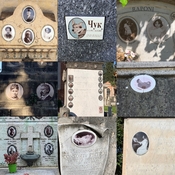BobUK
Member
At a funeral recently, I noticed a few gravestones having a small photographic portrait in a frame permanently attached to the headstone.
I thought it bad form to wander off and have a closer look at the time.
From what I could see some of the colour portraits were over thirty years old and had not faded at all in the bright light of day.
Does anyone know what process is used for these portraits ?
I thought it bad form to wander off and have a closer look at the time.
From what I could see some of the colour portraits were over thirty years old and had not faded at all in the bright light of day.
Does anyone know what process is used for these portraits ?






